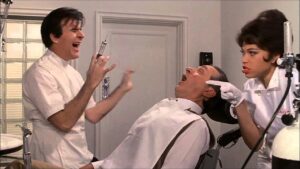I was sitting in the dentist’s waiting room waiting for a root canal. Then my ears perked up–I began to hear a familiar sound. It was a homey refrain from the solo guitar that was piped in as muzak in the waiting room to comfort us nervous root-canalers as we waited to be called to slaughter. Something about that tune struck a cultural memory as deep as the cavity my dentist was about to excavate.
Was it possible? I asked myself. I listened more intently to the soothing sounds. Yes, it certainly was; it was “Amazing Grace.”
It could have been a fluke, I thought. But then it was followed by another solo guitar riff, which I instantly recognized as “Come Thou Fount of Every Blessing.”
I asked the woman at the counter whether they had deliberately chosen hymn music for the waiting room. She looked puzzled.
“Hymn music?” she asked. She had no idea what that was. They simply turned to a station that provided soothing music 24/7.
The music soon turned to something else, something non-hymn. It was clear that it not an explicitly Christian music station, of which there are a billion, but simply one that specialized in playing some nice comforting tunes.
There may have been more hymns on the play list but I didn’t have time to listen for them. I was soon called in for my appointed destiny.
After the first shot of novocaine, when I was sitting in what I imagined had once been an electric chair, I tried to divert my attention away from whatever horrible things the dentist was preparing to do. I thought of all the other ways that religious music, hymnody in particular, has insinuated itself into what we regard as secular popular culture.
At Christmas time, of course, “Silent Night” sits comfortably beside “Rudolph the Red Nosed Reindeer,” and no one gives it a second thought. It’s all seasonal music.
The funeral tune for sailors, and increasingly all military and even elected officials is “Eternal Father, Strong to Save.” When I hear it my mind goes back to the sad procession for Jack Kennedy after his awful assassination. I briefly entertained the notion that if I never recover from this dental assault, “Eternal Father, Strong to Save” would be at my final service.
Just as Christian religious images and phrases have invaded the civil religion of America’s political life, the hymnody also has a role in our culture. It has firmly located itself in what might be called the cultural religion of everyday life.
I almost said that hymnody had invaded our secular culture, but I wondered about that term. The ubiquitous presence of hymns, along with the images of crusaders, charismatic leaders, covenantal communities and many other cultural features with biblical resonance gives witness to the role of religion in a culture that thinks it is secular. Our biggest holidays are religious ones, even Halloween and Mardi Gras. We can’t escape religion.
I don’t know whether that is good or bad. But it simply is.
We are often struck at the religiosity of other cultures, the somber piety of Muslim culture and the vibrant imagery of Hindu culture, for example. But it turns out that we have, whether we notice it or not, plenty of our own.
Eventually the dental attack, and my mental musings, came to an end. I was back in the waiting room scheduling the next appointment and listening for the solo guitar to play one more hymn. But the guitarist had moved on to other things, an Irish sea chanty, I recall.
Now my teeth are fine. The novocaine has worn off. But I’m still humming “Come Thou Fount of Every Blessing.” And I listen for hymns in the musical background of every elevator and grocery store. I’m sure I’ll hear some more of them in our allegedly secular culture.

